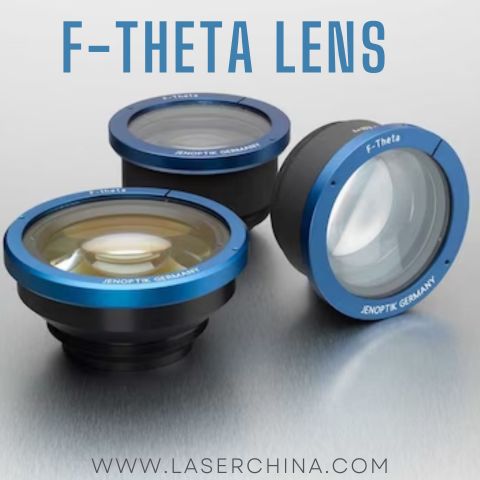
xr:d:DAF3Ua_aK6Q:6,j:6026228969770707027,t:23121809
In the realm of laser systems, accuracy is non-negotiable. Whether you’re marking, engraving, cutting, or welding, one element that often gets overlooked—but silently governs the outcome—is the F-theta lens. Unlike standard optical lenses that follow basic focal rules, the F-theta lens operates in a completely different optical philosophy. The way it manipulates light and focuses laser beams across a flat surface is not just a technical upgrade—it’s a necessity for any laser-based process that demands consistency across the work field.
In this guide, we’ll explore why the F-theta lens maintains precision when other lenses can’t, and what makes it a foundational tool in laser technology.
What Makes the F-theta Lens So Different?
The answer lies in geometry. A standard lens projects light in a curved field; it focuses light from a point source into a spherical plane. That works well in imaging or photography, but in laser applications—especially when the beam is directed across different positions using a galvanometer scanner—a curved focal field becomes a problem. The focus becomes inconsistent across the work surface, leading to non-uniform results.
This is where the F-theta lens shifts the paradigm.
The F-theta concept ensures that the laser beam remains sharply focused on a flat plane, regardless of its position in the scanning area. It does this by deliberately distorting the focal geometry using a combination of specially designed optical elements. The name itself comes from the formula:
Field Height (h) = f × θ
where f is the focal length and θ is the scan angle.
This direct linear relationship between the scan angle and the spot position allows the beam to travel evenly across the entire surface area, keeping the focal point fixed in one flat plane. That’s the core reason the F-theta lens is indispensable in galvo-based laser systems.
Where the F-theta Lens Truly Shines
The F-theta lens is not just a technical component—it’s the silent engine behind high-speed, high-precision laser workstations across various industries.
1. Laser Marking Systems
In laser marking, even minor deviations in focus lead to significant quality drops. The F-theta lens allows for uniform marking across the entire surface area. Whether marking metal serial numbers, QR codes on plastics, or logos on ceramics, the results remain consistent from center to edge.
2. PCB and Semiconductor Industry
In micro-processing environments, accuracy is measured in microns. Traditional lenses would introduce focal discrepancies that render precision patterns unreliable. The F-theta lens removes that variable, keeping micro-scale laser etching consistently sharp.
3. Medical Device Manufacturing
Regulatory demands in medical manufacturing leave no room for error. UDI codes must be permanently legible. Whether it’s surgical steel, titanium implants, or polymer tools, the F-theta lens guarantees repeatable outcomes across varying surface geometries.
4. Packaging and Plastics
Laser marking on consumer products, packaging films, and plastics often requires large working fields. With the F-theta lens, the laser beam scans across the entire width without sacrificing focus or speed, maintaining sharpness and readability at high throughput.
Optical Construction Behind the Precision
F-theta lenses are made using multi-element, computer-optimized glass optics. Each lens is engineered to produce a uniform spot size and minimal distortion across the scan field. Materials like fused silica are often used for their ability to withstand high laser energy without degrading.
Some versions also incorporate anti-reflective coatings to prevent energy loss and back reflection, especially in high-power fiber or CO₂ laser systems. The lens diameter, focal length, and wavelength-specific optimization are tailored to the exact requirements of the laser system.
Wavelength Compatibility: A Crucial Factor
F-theta lenses are not universal. Each is built for a specific laser wavelength. You’ll find variations such as:
-
1064nm for fiber lasers (used for metals)
-
532nm for green lasers (used for plastics and sensitive materials)
-
355nm for UV lasers (used in micro-machining)
-
10.6µm for CO₂ lasers (used for non-metals like wood, acrylic, glass)
Matching the F-theta lens to your laser wavelength is critical. A mismatch can lead to significant losses in beam quality and energy focus, directly affecting the quality of the process.
Spot Size and Working Field
The spot size—the diameter of the laser beam at the focus—is another factor influenced by the F-theta lens. A smaller spot size yields higher precision, which is essential in fine marking or micromachining. But increasing the working field (the area the lens can cover) typically enlarges the spot size.
The balance between spot size and field area is not a flaw but a design consideration. When selecting an F-theta lens, the intended application dictates whether you prioritize a small spot for detail or a large field for productivity.
How Alignment Affects Performance
Even with the best F-theta lens, improper system alignment can throw everything off. The lens must be precisely aligned with the laser source and scanner to maintain the integrity of the flat-field focus.
Professionals often use alignment lasers or CCD cameras to fine-tune lens positioning, especially in high-speed systems where even small angular errors can cause measurable drift in beam position.
Thermal and Mechanical Stability
In industrial settings, lasers often run for hours—sometimes days—without pause. The F-theta lens must maintain optical performance even under thermal load. This is why high-end lenses come in thermally stable housings with precision mounting threads to lock them in place during extended operation.
Some systems also incorporate active cooling or temperature monitoring to prevent focus drift due to thermal expansion, particularly in high-wattage applications.
Misconceptions About the F-theta Lens
Many newcomers to laser technology assume that any lens will do, or that the focus issue can be corrected digitally. That’s a costly assumption. While software compensation can help in some limited cases, only the F-theta lens provides the native optical correction needed for wide-field scanning applications.
Another myth is that larger lenses always mean better results. While a wider field of view is possible with larger lenses, they can also result in greater spot sizes, which may not be suitable for fine-detail applications.
Final Thoughts
The F-theta lens is not just a component—it’s the backbone of accuracy in modern laser systems. It bridges the gap between the physical constraints of laser optics and the industrial need for speed, precision, and repeatability. Whether you’re working with metal, plastic, wood, or silicon wafers, the integrity of your laser application depends heavily on the right F-theta lens setup.
Understanding its function and role allows engineers, technicians, and manufacturers to make informed choices about laser equipment—and ensures that every beam that leaves the scanner reaches its target with surgical precision.



